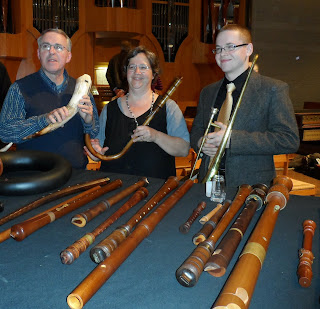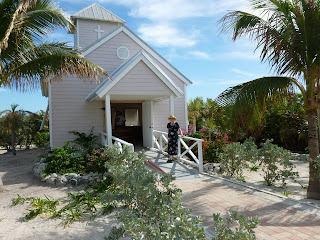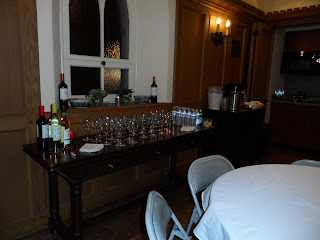Click on any picture to see it full size; use the back arrow or the ESC key to return to this page.
Dinner and Program featuring John Walker
Monday May 13, 2013
St. Andrew's Episcopal Church, College Park, Maryland
Dale Krider, Host
We began at 6 PM in the parish hall with appetizers before our buffet supper. Here Charlie Saxon of Office Catering has just finished setting up the table and is chatting with Sub Dean Emily Koons at the end of the table. In her position as Sub Dean, Emily has been responsible for all the programming for the past two seasons, and has set up many of the programs that will occur as she becomes Dean.
Having eaten most of the appetizers, we move on to supper and fill our plates. As usual, the food was delicious and there was more than enough. We had a good time chatting around the round tables, and they were close enough that we could speak with those at other tables.
At 7:30 PM we adjourned to the church, where we sat in the choir pews in the chancel for a short business meeting.
Then Dr. John Walker gave us a talk on "A Funny Thing Happened At Church", both to him and to others. This was quite amusing. He ended with telling us about meeting Dr. Dale Krider as they began to set up the Committee for the Part Time Organist at the National AGO office.
Dr. Krider described how the Committee came up with the January Jubilee, the first of which was held in our area at Christ Congregational Church in Silver Spring, Maryland, with many of our members assisting. These have become popular and will be held around the country next year. They offer several classes for part time organists to learn many facets of their positions.
After that we began the concert portion of our program. The first piece was "Trilogie” by French Canadian composer Denis Bédard (Edition Cheldar), an
organ duet played by Dr. Walker and Dr. Krider. This was in three pars and was interesting.
Following this Dr. Walker played the "Adagio in E Minor" by Herbert Nanney, one of his former teachers. This also was in sections. I was sitting next to Emily Koons, who remarked that she was not aware this was an E.M. Skinner organ, but it sure sounded like it! This was a lot of fun to hear.
The final work was the well-known "Prelude and Fugue on BACH" by Liszt. Dr. Walker was kind to those of us in close proximity, and did not fire off the Festival Trumpet or ring the Tower Bells, but we did hear and feel the rest of the organ, including the big 32' stops.
Many thanks to Dr. Krider and St. Andrew's Church for hosting the event, and to Dr. Walker for his great presentation.
This is from the first movement of the duet.
This is the second movement.
The beginning of the third movement.
The end of the third movement.








































